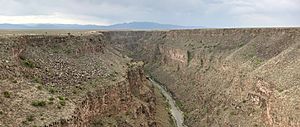Taos Plateau volcanic field facts for kids
The Taos Plateau volcanic field is a huge area in Taos County, New Mexico, United States, where many volcanoes once erupted. It's the biggest volcanic field in a large crack in the Earth called the Rio Grande Rift. This field covers more than 7,000 square kilometers (about 2,700 square miles)!
Most of the volcanoes and lava flows here are very old. They formed between 1.8 and 4 million years ago. Some parts are even older, about 22 million years old. The lava that came out was different types. Some was dark, runny lava called basalt. Other lava was lighter and thicker, called rhyolite. You can see different volcano shapes here, like flat lava sheets, cone-shaped hills called cinder cones, and wide, gently sloped volcanoes called shield volcanoes. The flat lava sheets, known as Servilleta Basalt, are easy to see in the deep Rio Grande Gorge. The highest point in this volcanic field is San Antonio Mountain, which is about 3,325 meters (10,908 feet) tall.
Volcanoes of the Taos Plateau
This volcanic field has at least 35 different places where lava erupted, called vents. They are spread out in a circle about 50 kilometers (30 miles) wide. The volcanoes in the middle of the field mostly erupted dark, runny basalt lava, forming shield volcanoes. As you go further out, the volcanoes erupted different kinds of lava, like andesite and rhyodacite. These lavas are a bit thicker. There are also two small rhyolite domes right in the center, which are a bit unusual for that area.
Some of the tallest and most well-known mountains in this volcanic field are:
- San Antonio Mountain: This is the highest point, standing at 3,325 meters (10,908 feet).
- Ute Mountain: This mountain reaches 3,076 meters (10,093 feet) high.
- Cerro de la Ollaute mountain: It's 2,887 meters (9,475 feet) tall.
- Cerro del Aire: This peak is 2,750 meters (9,023 feet) high.
- Cerro Chiflo: Standing at 2,736 meters (8,978 feet).
How the Volcanoes Formed
The Taos Plateau volcanic field is located where a major crack in the Earth, the Rio Grande rift, meets another geological feature called the Jemez Lineament. In this spot, hot rock from deep inside the Earth's mantle (the layer below the crust) pushed upwards. This upward movement caused the hot rock to melt as the pressure decreased. This melting created the runny basalt lavas.
The lavas that formed the outer parts of the field, like andesite and rhyodacite, came from less melting. The two rhyolite domes in the center formed when magma (melted rock) cooled and changed as it moved closer to the Earth's surface. This process is called fractional crystallization.


